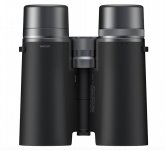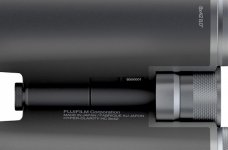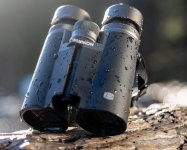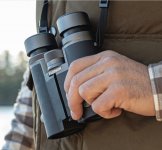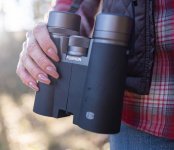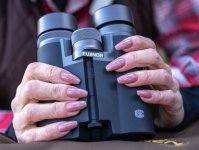Keeping track of how this "currently popular model" does over the next twenty years would be a little easier if you'd deigned to
actually mention what it was... but having done a little amateur sleuthing, I think (...do get your arteries ready...:cat

it would not be a total surprise if said binocular was in fact able to give 20 years of service to the average weekend/holiday birder. But we can confer on that in 20 years' time...
I know folks have delighted in being Luddite since before John Ludd was a twinkle in his father's eye. But (and it seems almost ridiculous to have to say this) ask any mariner if he'd like to go back to navigating by chart and compass, or an air force ground crewman whether they'd prefer their pilots to fight in F-22s or Spitfires. Likewise (...got your arteries ready again?...), not many folks who know what they are doing - or even those who don't, but are given the opportunity to try both - would choose Mr O'Gara's 84-year old Zeiss, lovely though it is, in preference to the "currently popular model" for the job of finding and identifying birds. And hey... but for the marvellous complexity of your computer, you'd be able to broadcast your opinions only to those fortunate few whom you could reach by print or by voice, instead of all over the far reaches of the internet...
PS. Pray tell us which of the "almost every" parts in BF 4 are plastic... and why exactly plastic is a poor choice for the purpose that part is intended to fulfil? You've got more experience working on binoculars than all the rest of us put together, we're fully cognizant of that - so go on, enlighten us...
Ah, Patudo,
Having high blood pressure and already having had one stroke, I ALWAYS have my arteries prepared anytime I see a message from you, waiting. I don’t see you as wanting to raise the bar of understanding for yourself or others. But rather, make a point of challenging or attacking. But while explanations don’t seem to work well for you, I’ll spend more time trying to bring peace to the playground.
“Current popular model?” I don’t care what it is. Is that a sacrilege? Again, my comment was based on a track record of paying attention to binoculars and the industry that produces them. I always hope that negative comments I’ve made concerning any instrument are wrong. Too often, however, my thoughts have gelled into sad realities. I’ll let you have the last word on that since I won’t be around in 20 years.
Being Luddite: Often, pompous or shallow tinkers have an inclination to believe older folks are somehow frightened of new technology. That, however, seems built on the unwavering notion that newer is better. Like it or not that is frequently not so.
I find it interesting that you would drop back to OLD reasoning:
“Ask any mariner if he'd like to go back to navigating by chart and compass ...”
Using a modest GPS, you can watch your position on the globe change as you walk from one side of your vessel to the other. That’s fantastic! At least until it goes out somewhere between San Francisco and Honolulu, and it HAS HAPPENED. The OLD TECHNOLOGY sextant (properly repaired and collimated) CAN never go out. And those with enough sense to understand how it works can steer a reliable course ... every time. And NOAA charts have long been available, digitally. They are infinitely more convenient, in so many ways, than paper charts. But, once again they are dependent on electronics. I’ve written for 18 marine magazine titles—have been a staple with
Dockside and
Latitudes & Attitudes—and all those publishers seem to think I know what I’m talking about—‘got a piece coming out soon in
SAILING. I guess I have them fooled, huh?
My arteries are holding up just fine.
“... not many folks who know what they are doing - or even those who don't, but are given the opportunity to try both - would choose Mr O'Gara's 84-year old Zeiss, lovely though it is, in preference to the "currently popular model" for the job of finding and identifying birds.”
Mathematically you are absolutely correct!!! And I certainly know where you’re coming from. But you must be a younger fellow because you continue missing the bigger picture. That bigger picture, as I have proffered MANY TIMES, involves
individual physiological aspects. In that case, you are absolutely ... wrong.
Would you presume to tell Michael how foolish he is for his choice? Don’t you think that’s a bit pompous?! By the way, my “amateur sleuthing” tells me you have access to a Nikon WX. Like the Nikon that is featured in this thread, would I be wrong for sharing my thoughts concerning its arrival in the market? But wait, the old guy wasn’t wrong ... again.
PS. Pray tell us ... so go on, enlighten us...
I sure wish you didn’t feel the need to be incessantly snotty with me.
Plastic is a totally adequate material for certain parts of binoculars. But one need not be a Rhodes Scholar to see that having 6.18 times as many parts as the mentioned Zeiss constitutes an overkill with production requiring more money which will undoubtedly be passed on to the consumer. But then, I’m sure—that makes no sense to the
DISCONTINUED WX brigade.
A Story—Please bear with me; it’s a tiny bit off-color and I haven’t found the time to water it down in such a way as to allow it to keep its importance:
An old bull is leisurely munching grass on a hilltop overlooking the barnyard when a young bull-calf bounces up to him and excitedly announces that they should
RUN down the hill and make love to a beautiful heifer. The old bull raises his head slowly and looks for a second at the yearling, who is still bouncing and vibrating, before turning back to the grass.
Frustrated, the yearling raises his voice and says, “How about it, how about it; ‘you game?”
At that point, the old bull raises his head and says, “Let’s
WALK down the hill and make love to several beautiful heifers.”
Read into that what you will, but know I am still wanting to be a friend. Know also that your challenges or attacks say much more about your aggressive, contrary, and often ill-informed agenda than it does about me and mine.
If you will excuse me now, there’s a fellow in Georgetown, Texas who wants me to get to the repair of his 8x30 Leitz Binuxit.







